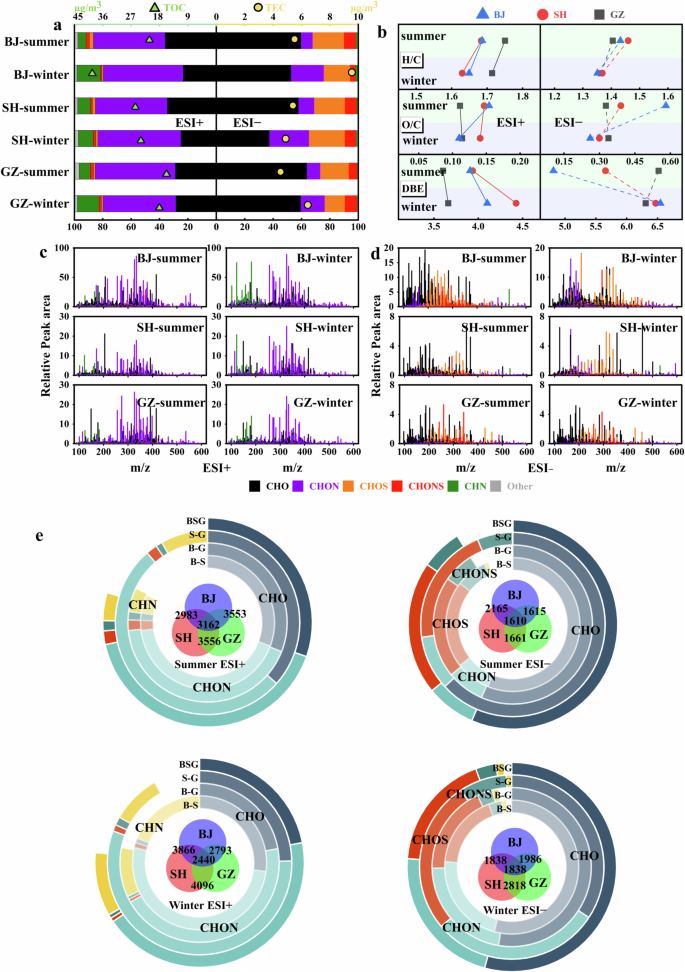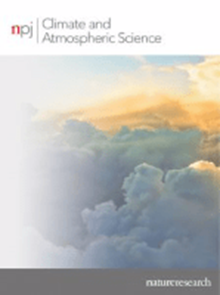Molecular characterization of atmospheric organic aerosols in typical megacities in China
IF 8.5
1区 地球科学
Q1 METEOROLOGY & ATMOSPHERIC SCIENCES
引用次数: 0
Abstract
Atmospheric aerosols in megacities impact air quality and public health. However, limited information exists on the detailed molecular composition of organic aerosols in urban areas. This study characterized the molecular composition of organic aerosols (OA) in Shanghai, Beijing and Guangzhou, China, during summer and winter of 2021. Liquid chromatography-orbitrap mass spectrometry detected 4536−5560 and 2067− 3489 organic molecular formulas in positive (ESI+) and negative (ESI−) electrospray ionization modes, respectively. CHO and CHON compounds accounted for over 80% and 60% of total abundance in ESI+ and ESI−, respectively, suggesting their significant contribution to urban OA. The number and abundance percentages of CHO showed obvious seasonal variation, with more CHO in summer than in winter, while CHON exhibited the opposite trend in Beijing and Shanghai. Compared with winter, a lower unsaturation degree, reduced aromaticity, and higher oxidation state of OA in summer were observed in Beijing and Shanghai, while these seasonal variations were not as obvious in Guangzhou, likely due to regional climate differences. The number percentage of common compounds between Beijing and Shanghai was higher than that between Guangzhou and Beijing (or Shanghai). Nitroaromatic compounds were more prevalent in winter than in summer. Further analysis of atmospheric formation relevance and precursor-product pairs suggested that CHON compounds are derived from the oxidization or hydrolyzation processes, revealing potential chemical transformations of these aerosols. This study characterized the chemical makeup of organic aerosols, providing insight into their sources and characteristics in these cities.


中国典型特大城市大气有机气溶胶的分子特征
特大城市的大气气溶胶会影响空气质量和公众健康。然而,有关城市地区有机气溶胶详细分子组成的信息十分有限。本研究描述了 2021 年夏季和冬季中国上海、北京和广州有机气溶胶(OA)的分子组成。在正离子(ESI+)和负离子(ESI-)电喷雾电离模式下,液相色谱-轨道质谱分别检测到 4536-5560 和 2067- 3489 个有机分子式。CHO和CHON化合物在ESI+和ESI-中分别占总丰度的80%和60%以上,表明它们在城市OA中占有重要地位。CHO的数量和丰度百分比表现出明显的季节性差异,在北京和上海,CHO的数量和丰度百分比在夏季多于冬季,而CHON则表现出相反的趋势。与冬季相比,北京和上海夏季 OA 的不饱和度降低、芳香度降低、氧化态升高,而广州的季节性变化并不明显,这可能是由于地区气候差异造成的。北京和上海的常见化合物数量百分比高于广州和北京(或上海)。硝基芳香族化合物在冬季比夏季更为普遍。对大气形成相关性和前体-产物对的进一步分析表明,CHON 化合物来自氧化或水解过程,揭示了这些气溶胶的潜在化学转化过程。这项研究描述了有机气溶胶的化学构成,为了解这些城市的有机气溶胶来源和特征提供了依据。
本文章由计算机程序翻译,如有差异,请以英文原文为准。
求助全文
约1分钟内获得全文
求助全文
来源期刊

npj Climate and Atmospheric Science
Earth and Planetary Sciences-Atmospheric Science
CiteScore
8.80
自引率
3.30%
发文量
87
审稿时长
21 weeks
期刊介绍:
npj Climate and Atmospheric Science is an open-access journal encompassing the relevant physical, chemical, and biological aspects of atmospheric and climate science. The journal places particular emphasis on regional studies that unveil new insights into specific localities, including examinations of local atmospheric composition, such as aerosols.
The range of topics covered by the journal includes climate dynamics, climate variability, weather and climate prediction, climate change, ocean dynamics, weather extremes, air pollution, atmospheric chemistry (including aerosols), the hydrological cycle, and atmosphere–ocean and atmosphere–land interactions. The journal welcomes studies employing a diverse array of methods, including numerical and statistical modeling, the development and application of in situ observational techniques, remote sensing, and the development or evaluation of new reanalyses.
 求助内容:
求助内容: 应助结果提醒方式:
应助结果提醒方式:


